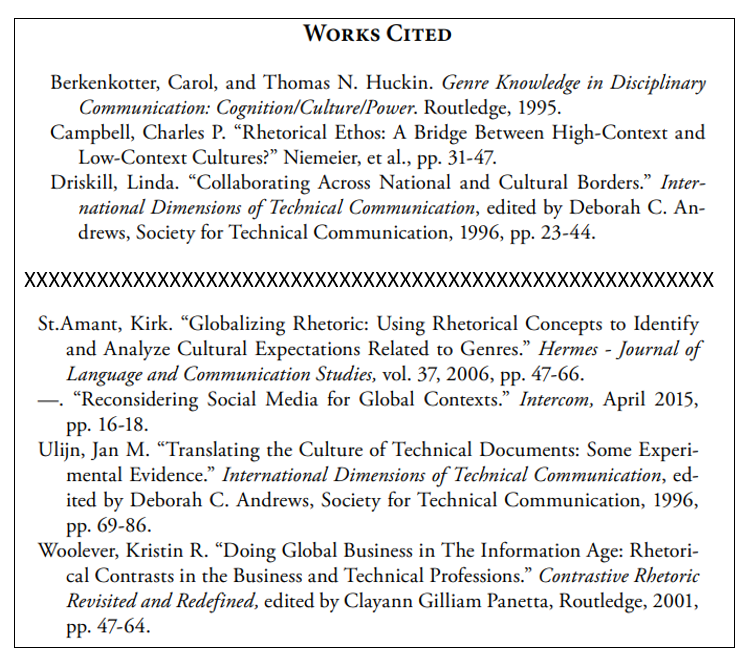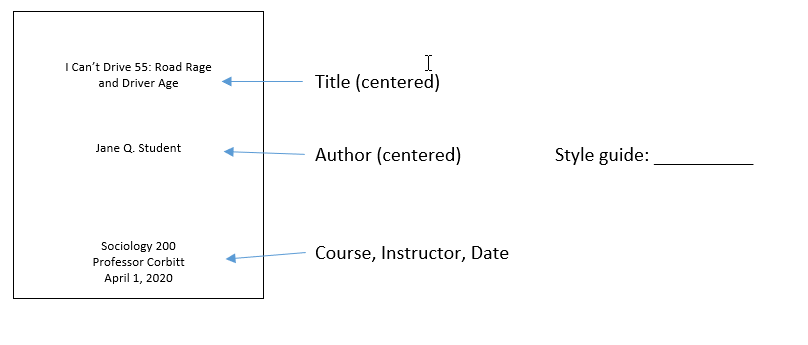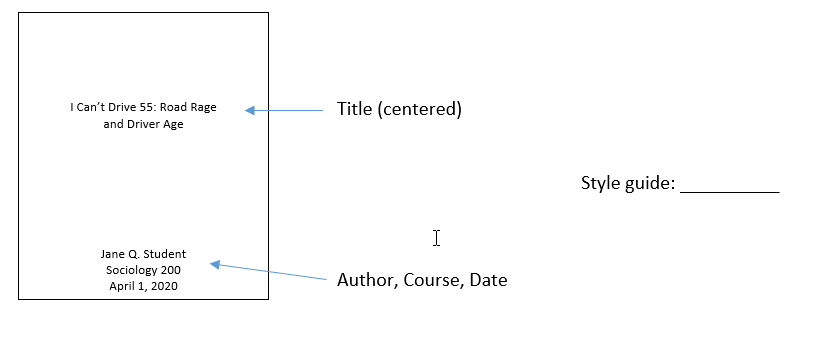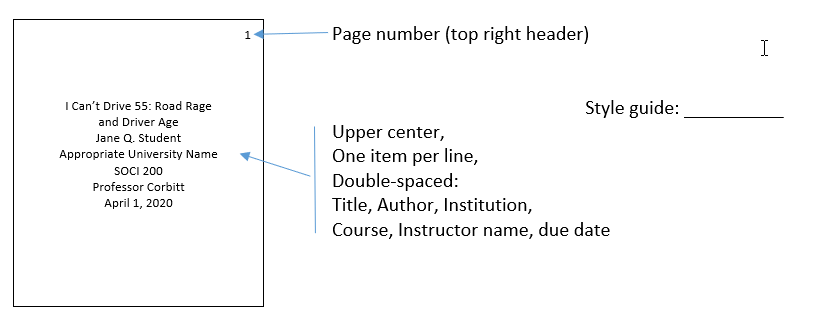Selecting a Style Guide
Stacey Corbitt
Chapter Overview
Students can be perplexed by the rigor applied to citing sources in research writing. Often they wonder how useful their work is when it seems like there are in-text citations on every other line: it may suggest (to the inexperienced student) they didn’t employ any original thought when writing the research report. However, experts and novices alike recognize the need to give credit to their mentors and colleagues. It is no surprise that different fields follow different methods of acknowledging sources: however, the challenge of following a style can be knowing its rules. This chapter aims to help students understand how to select and adhere to a citation and referencing system that meets the needs of their assignments as well as the standards of professionalism required by their fields of study and work.
Michael J. Klein and Kristi L. Shackelford published an essay in 2011 introducing the importance of document design. Read the following excerpt from their chapter in Writing Spaces: readings on writing (Volume 2, pp. 340-341) and discuss your experience as a writer.
The Basics of Style Guides
Does your university or organization have a specific style guide representatives are expected to follow when publishing work? How can you find out if you don’t already know the answer?
Which (if any) of the commonly-used style guides in Table 1 below have you encountered in previous courses? What do you remember or know about the assignment(s) and why that style guide was used? Be prepared to discuss your responses in class or as directed by your instructor.
Table 1. Selected commonly-used style guides
| Style | Organization | Fields where used | Features |
|---|---|---|---|
| AP | Associated Press | Print journalism; public relations | Quotations and paraphrases are integrated using signal words but without citations or reference list |
| APA | American Psychological Association | Academics; social sciences; business; some engineering; and education | In-text citations with publication date focus (Author, year); reference list alphabetical by authors’ surnames |
| Chicago (CMOS) or Turabian | University of Chicago Press | (i) Humanities; and (ii) social sciences and sciences | 2 systems: (i) notes and bibliography (footnotes /endnotes with superscript numbers); and (ii) author-date (in-text citations similar to APA) |
| CSE | Council of Science Editors | Physical science; natural science; and mathematics | 3 systems: name-year (like APA); citation-sequence (like IEEE with superscript numbers); and citation-name (citations and reference list alpha by authors’ surnames with superscript numbers) |
| IEEE | Institute for Electrical and Electronics Engineers | Technical fields; some engineering; and computer science | In-text citations with bracketed numbers referencing bibliography entries; numeric reference list in order sources appear in text |
| MLA | Modern Language Association | Humanities, especially language and literature | Author-page in-text citations; works cited list alphabetical by authors’ surnames |
Style guides and source identification
Academic and professional writing that makes an argument usually provides evidence to support that argument. In some research writing, evidence may be the original information the author(s) found through their primary discovery processes. Most research reporting, however, relies on at least some evidence the authors obtained from the findings published by other experts in the same or related field(s). All evidence – whether quoted, paraphrased, or summarized – originally developed by another scholar must be attributed to that original source. The attribution of source material is an in-text citation placed by an author in a document at the point where the sourced material is provided.
Activity: Identify a style by examining its in-text citation method
Consider the following example (St. Amant, 2020, p. 149) of attribution using in-text citation:
Who is your audience/for what culture are you writing?
Review the passage again carefully and highlight each in-text citation. How many different sources were attributed in the passage? What information is included in the citations?
Now, compare the information in your answer above to the “Features” column in Table 1. Which style guide do you think the author was using? Explain your answer.
Style guides and reference usability
In addition to in-text citations, style guides provide conventions for listing complete references at the end of a document so readers may access the same information writers used as evidence to support their claims. Consider the excerpt below (St. Amant, 2020, p. 159) from the reference list for the passage you read and highlighted above:

If you determined based on your review of the in-text citations that the author Kirk St. Amant followed MLA style, you can probably assume the reference list (“Works Cited”) is likewise presented using the MLA style guide: an individual document should adhere to only one style guide. What conventions does the list employ to indicate the author followed MLA guidelines?
Finally, notice in the Works Cited list that the author listed two different documents he wrote and published previously: in other words, he cited himself. For the second citation, he omitted his name as the author, as provided by MLA style. Using the link provided in Table 1 or another source of information about MLA style, search for the part of the style guide that provides for the omission of the author’s name in a second or subsequent work included in a reference list.
Answer the following prompts, including citation(s) for where you found the answer(s), and be prepared to discuss your findings with your classmates.
1. Did Kirk St. Amant cite his own previous work properly in the passage? How do you know?
2. Did he list his own previous publications in the Works Cited list properly? How do you know?
3. Why should an author cite him/herself in an original piece of work? Be prepared to discuss.
Style guides and document formats
Style guides are developed, maintained, and updated for use by various professional and academic organizations in an effort to make publications more uniform and, in turn, more accessible to broad audiences. In your own field of study, you may find that a certain style guide becomes familiar to you simply because your research activities lead you to discipline-specific publications that employ a particular style guide most of the time. As you have explored in the activities so far in this chapter, in-text citations may give readers good clues about the style guide an author has followed; and examining reference lists may support your guess at what style guide was used. In terms of academic writing and professional publications, however, the third component of most style guides is even more specific and telling about the style a document follows. That component addresses the ways in which authors format a document.
Document formats for student writers
As a pre-college student, you may have been required to write and submit papers using MLA format. In college, the required format for papers may have changed to APA format. Whatever your own situation, you know that parameters were set for things like in-text citations; lists of references used in your research; and formatting, which describes the way your paper looks on paper. Some style guides provide extensive details about formatting, while others provide few details or none at all. As a college student, however, it is imperative that you demonstrate your ability to follow directions and pay attention to detail. One way to exercise these abilities is to carefully follow assignment specifications, particularly as they relate to formatting reports, essays, and other assigned documents according to the conventions of a prescribed style guide.
Activity: Formatting requirements for title pages
Using the links in Table 1, a college writing handbook, or online student writing guide of your choice, identify the style guide represented by each of the following three title page layouts:



Clearly, the variations among style guides are not extreme – but, each is different. Recognizing and adhering to those differences is significant for students to demonstrate sufficient attention to detail resulting in writing that is complete and correct.
Document formats for professional publications
Your instructors will probably provide you with the details necessary to complete your assignments using the appropriate style guides and other specifications. In part, teachers make such efforts to help students prepare for world of work situations in which such guidelines must be discovered as part of the process of preparing documents for publication. Following are some examples of professional situations you may encounter.
Peer-reviewed research journals
Some universities offer opportunities for undergraduate students to participate in scholarly research as part of a team. In those instances, the resulting research report may be submitted for publication in a peer-reviewed journal. Such publications vary widely on specifications for manuscripts, but one constant remains: they all have some required set of conventions.
- The Journal for Obstetric, Gynecologic, and Neonatal Nursing (JOGNN), for example, specifies the use of APA style for particular portions of manuscripts submitted for possible publication.
- Other professional journals, such as Advances in Mechanical Engineering (AIME), may be published by a company that has its own customized variation on a standard style guide. In the case of AIME, for example, the Vancouver style customized for the publishing company Sage Publications is required.
Branded corporate documents
Companies other than publishing houses also rely on style guides to ensure communications and branded activities send consistent, high-quality messages that present the entity in favorable ways. For example, specific color formulations, fonts, capitalization and abbreviation standards may be specified in publication guides to which employees must carefully adhere. Logos and all manner of presentation formats may be available in a company’s intranet, and all company representatives access and use those templates for business purposes. Generally regarded as intellectual property of an organization, examples are difficult to find for use here. You should ask about company style sheets and approved templates when you begin working for an employer so you will be prepared for any writing tasks on behalf of the company.
Professional and academic organizations
The technical writing style guide identified above in Table 1 as “IEEE” was first developed specifically for publication of documents in connection with the organization that created and maintains the style: that is, the Institute for Electrical and Electronics Engineers. While the style guide itself is preferred by many different types of professional engineers, it is required for “IEEE Transactions, Journals, and Letters” (IEEE, 2019, p. I-3). IEEE and some other organizations, including many universities, have robust collections of templates, logos, and specifications that make up their style guides.
Chapter conclusion
The point to remember is that there is almost always a style guide you should follow in preparing an academic or professional technical document. In an assignment, the style guide is often specified; but in professional writing situations, you may need to look for the guidelines – and they might be very specific to the publishing organization. Writers will always do well to search for the answer to “what’s the style guide to use?” and also to obtain a copy and follow it carefully. Never make it easy for anyone to discount what you write because you failed to adhere to specifications.
Homework
After 10 years of learning and adhering to The Publication Manual of the American Psychological Association (6th Edition), students and professional writers are now adjusting to the updated 7th Edition, published in October 2019. Focus on practicing how to write reference list entries for different types of sources in accordance with APA style.
1. Work with a partner in class to locate and download an example of each document type listed below:
· a webpage authored by an organization
· a journal article
· a book
· a government agency report
2. Use the handouts provided in the following several pages to carefully format the reference list entries for each of the sources you downloaded.
3. Draft a References page using the entries you formatted.
4. Exchange lists with your partner from Step 1 and conduct a peer review as directed by your instructor.
https://www.alverno.edu/media/alvernocollege/library/pdfs/apa7book.pdf
https://www.alverno.edu/media/alvernocollege/library/pdfs/apa7journal.pdf
https://www.alverno.edu/media/alvernocollege/library/pdfs/apa7journal.pdf
https://www.alverno.edu/media/alvernocollege/library/pdfs/apa7report.pdf
References
Alverno College Library (2020, July 15). Citing sources: APA 7. https://libguides.alverno.edu/citingsources
Institute for Electrical and Electronics Engineers (2019). Editorial style manual for authors.
Klein, M. J. and Shackelford, K. L. (2011). Beyond black on white: document design and formatting in the writing classroom. In Lowe, C. and Zemliansky, P. (Eds.), Writing spaces: readings on writing, Vol. 2 (pp. 333-349). License: CC-BY-NC-ND 3.0.
St. Amant, K. (2020). Writing in global contexts: composing usable texts for audiences from different cultures. In Driscoll, D., Stewart, M. and Vetter, M. (Eds.), Writing spaces: readings on writing, Vol. 3 (pp. 146-161). License: CC-BY-NC-ND 4.0.
